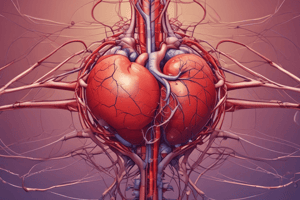Podcast
Questions and Answers
The typical heart is approximately the size of a grapefruit.
The typical heart is approximately the size of a grapefruit.
False (B)
The weight of a female heart ranges from 250 to 300 grams.
The weight of a female heart ranges from 250 to 300 grams.
True (A)
Hypertrophy in cardiac muscle results in the decrease of cell size due to exercise.
Hypertrophy in cardiac muscle results in the decrease of cell size due to exercise.
False (B)
The human heart consists of three chambers: one atrium and two ventricles.
The human heart consists of three chambers: one atrium and two ventricles.
The pulmonary circuit transports oxygenated blood to the lungs.
The pulmonary circuit transports oxygenated blood to the lungs.
The hearts of well-trained athletes are generally larger than those of nonathletes due to exercise.
The hearts of well-trained athletes are generally larger than those of nonathletes due to exercise.
Enlarged hearts caused by exercise will always show noticeable symptoms.
Enlarged hearts caused by exercise will always show noticeable symptoms.
The systemic circuit returns relatively deoxygenated blood to the lungs.
The systemic circuit returns relatively deoxygenated blood to the lungs.
A human heart contracts approximately 39 million times in one day.
A human heart contracts approximately 39 million times in one day.
The apex of the heart is located just to the right of the sternum.
The apex of the heart is located just to the right of the sternum.
The great veins include the superior and inferior venae cavae.
The great veins include the superior and inferior venae cavae.
The human heart is situated within the mediastinum, which is a space between the lungs.
The human heart is situated within the mediastinum, which is a space between the lungs.
The pericardium is a tough membrane that completely surrounds the heart.
The pericardium is a tough membrane that completely surrounds the heart.
The base of the heart is found at the level of the fifth rib.
The base of the heart is found at the level of the fifth rib.
The shape of the heart resembles a pinecone.
The shape of the heart resembles a pinecone.
The cardiac notch is a projection found in the left lung's medial surface.
The cardiac notch is a projection found in the left lung's medial surface.
Flashcards are hidden until you start studying
Study Notes
Importance and Function of the Heart
- Average heart contraction rate: 75 beats per minute.
- Approximately 108,000 contractions occur daily; over 39 million yearly; nearly 3 billion in a lifetime of 75 years.
- The heart is located in the thoracic cavity, between the lungs, in the mediastinum.
Anatomical Position and Structure
- The heart is separated from other mediastinal organs by the pericardium (pericardial sac).
- The pericardial cavity allows the heart to function without friction.
- The dorsal surface rests near vertebrae; the anterior surface sits beneath the sternum and costal cartilages.
- Great vessels (superior/inferior venae cavae, aorta, pulmonary trunk) attach to the heart's base, located at the third costal cartilage.
- The apex is positioned left of the sternum between the fourth and fifth ribs.
- The right side of the heart is anteriorly deflected, while the left side is posteriorly deflected.
Heart's Shape and Size
- The heart resembles a pinecone: broad at the base, tapering to the apex.
- Dimensions: about 12 cm (5 in) long, 8 cm (3.5 in) wide, 6 cm (2.5 in) thick.
- Female heart weight: 250-300 grams (9-11 oz); male heart weight: 300-350 grams (11-12 oz).
Athlete and Heart Muscle Adaptation
- Athletes may have larger hearts due to hypertrophy, building muscle without increasing cell numbers.
- Athlete's hearts pump more efficiently at lower rates compared to nonathletes.
- Hypertrophic cardiomyopathy can cause heart enlargement due to unknown factors, posing risks of sudden death in healthy individuals.
Heart Chambers and Circulation
- The heart consists of four chambers: right atrium, right ventricle, left atrium, and left ventricle.
- Atria receive blood; ventricles are the primary pumping chambers.
- Two primary circulation circuits: pulmonary (to/from lungs for gas exchange) and systemic (oxygenated blood to body tissues).
- The pulmonary circuit handles gas exchange, expelling carbon dioxide and procuring oxygen.
Studying That Suits You
Use AI to generate personalized quizzes and flashcards to suit your learning preferences.




